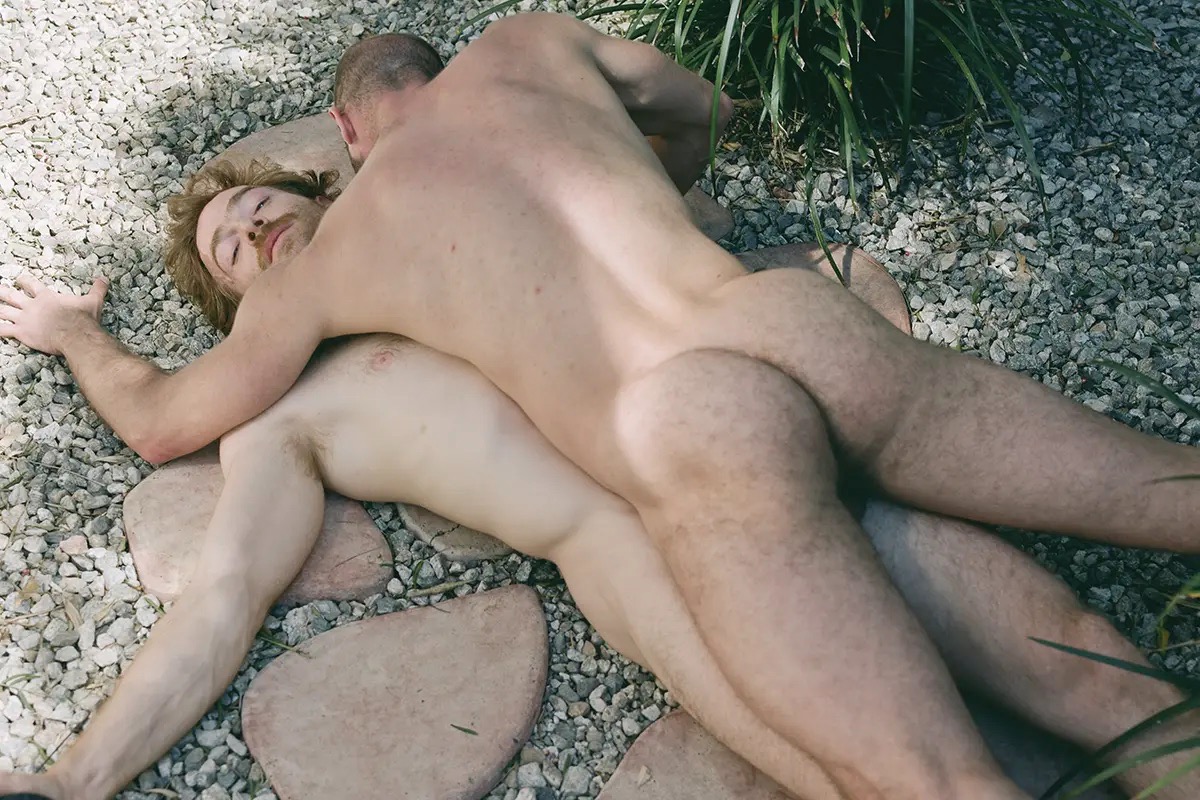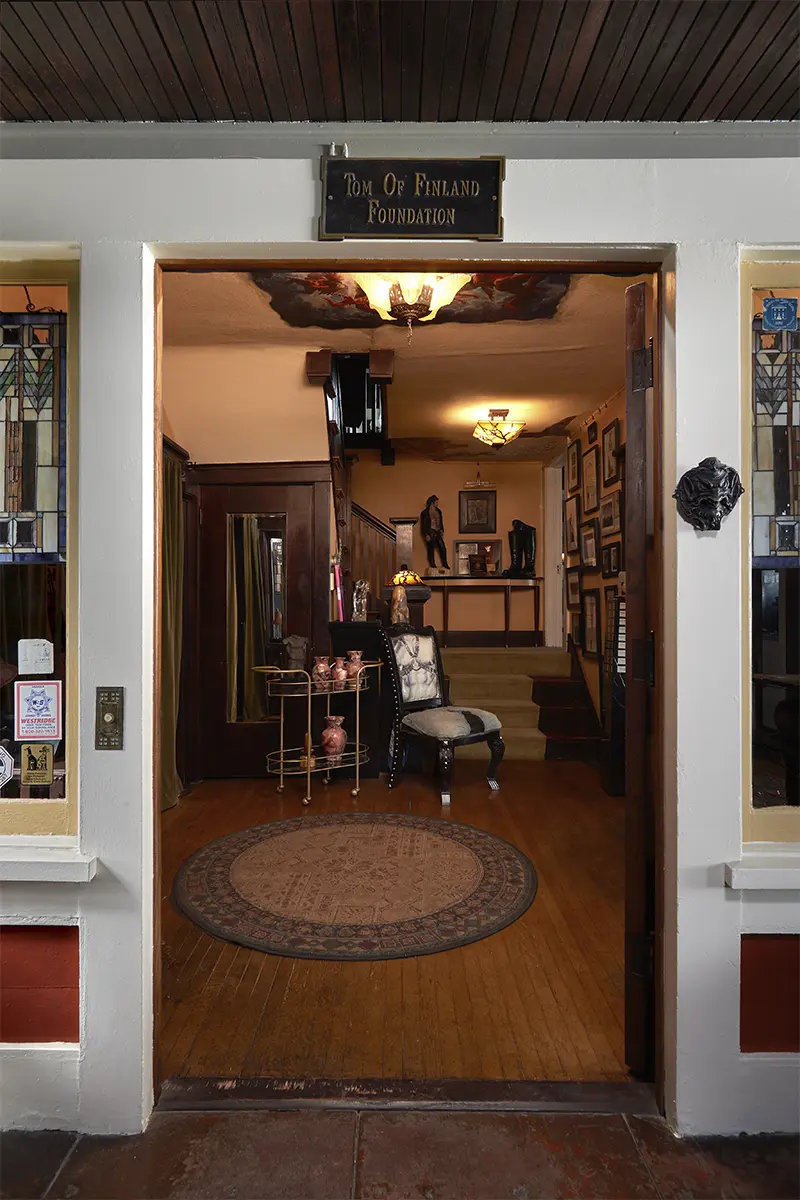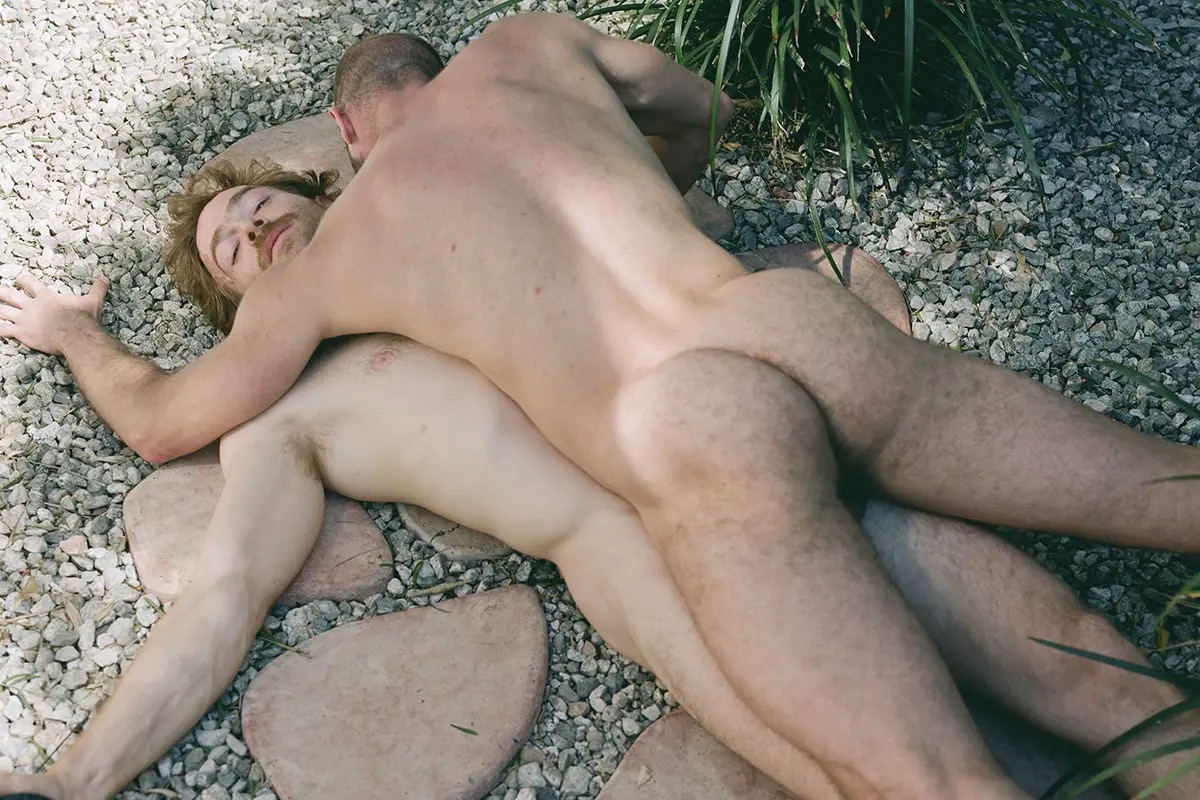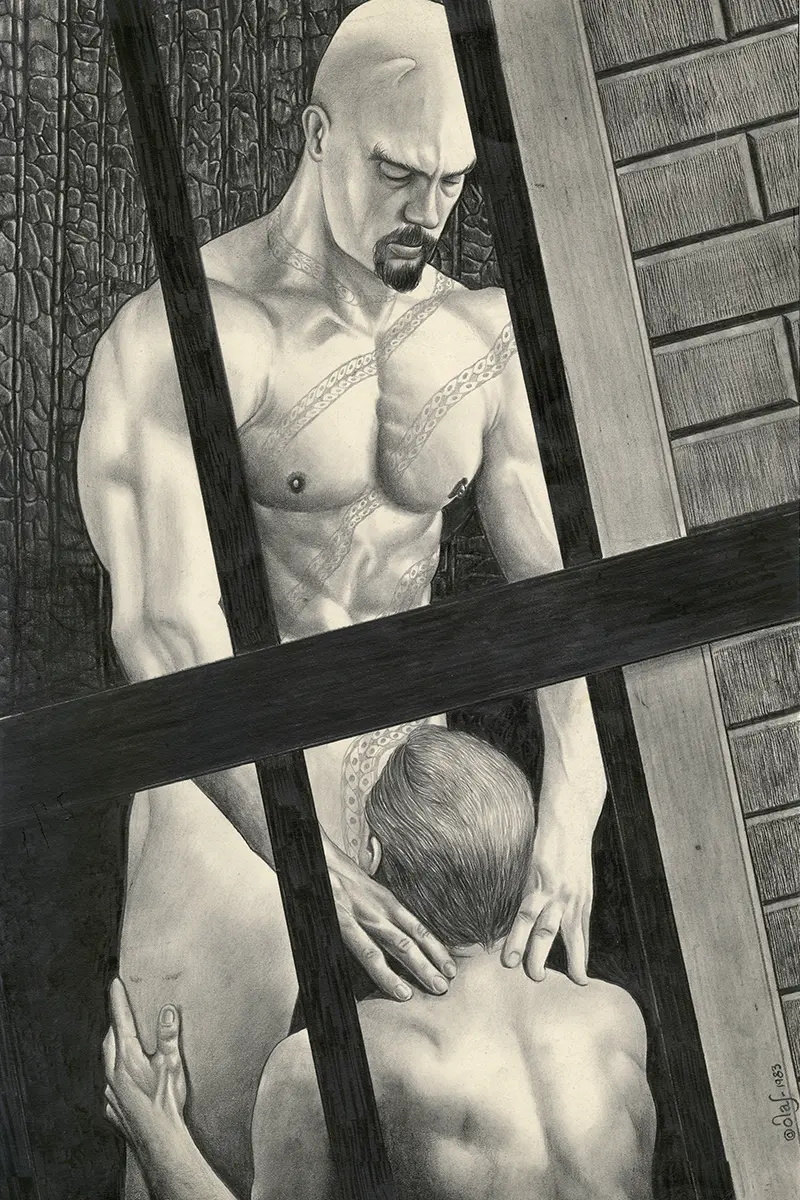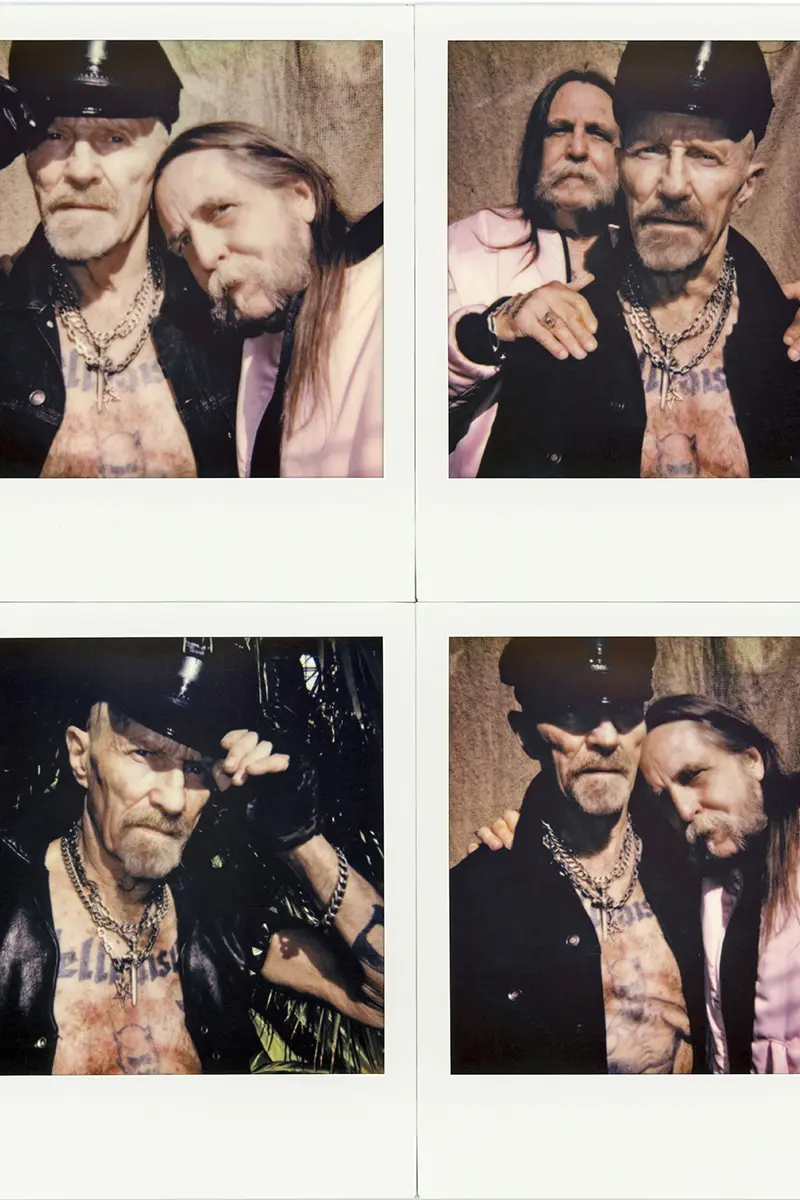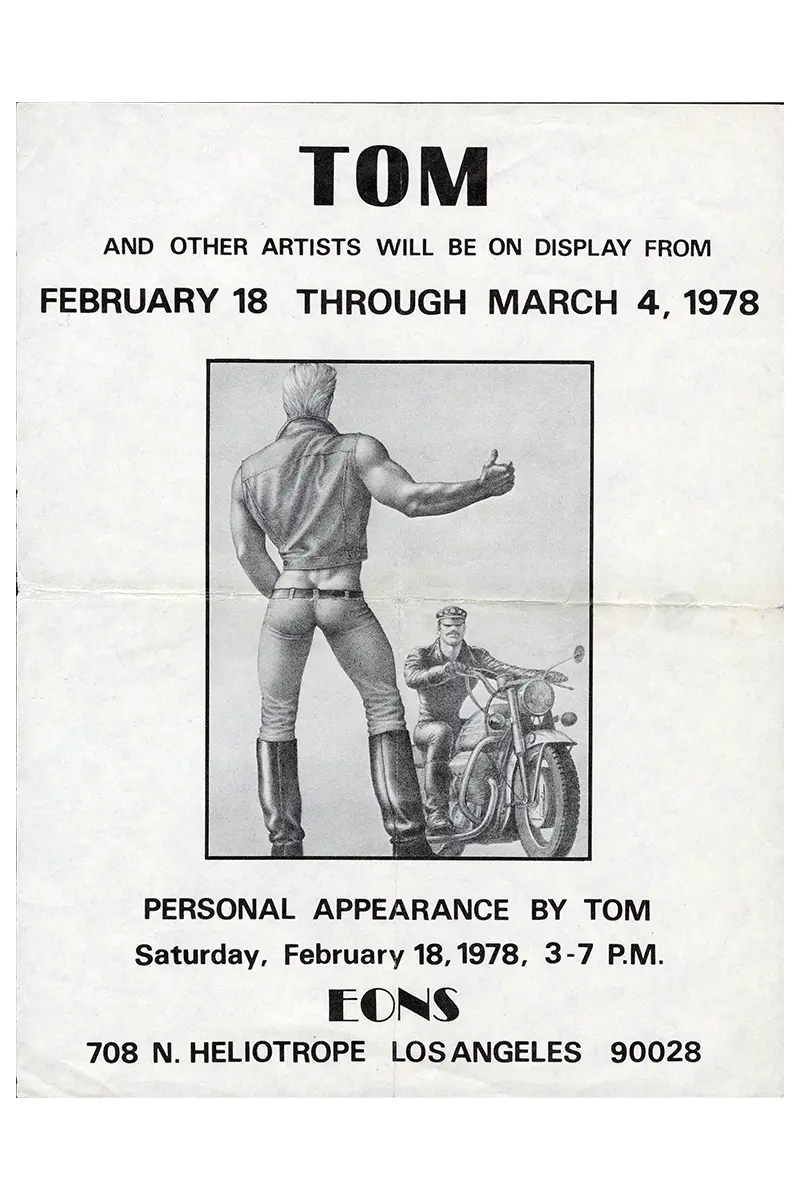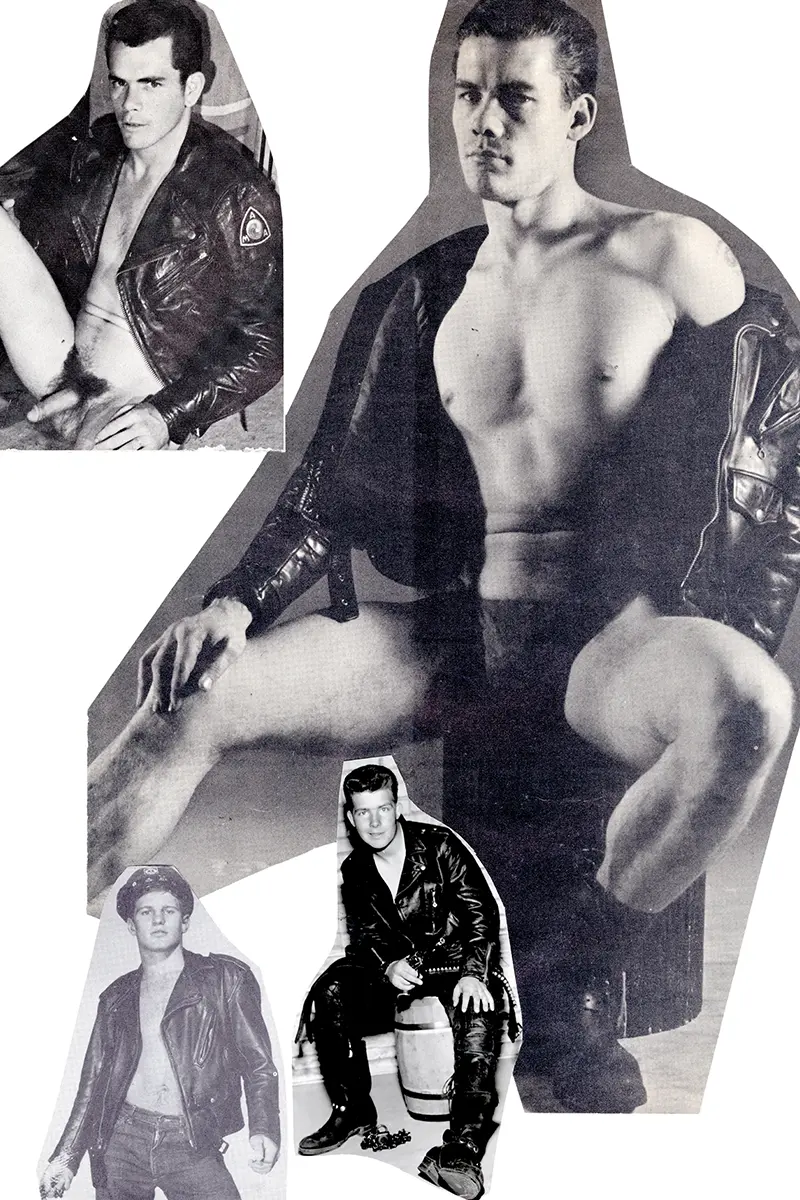Durk Dehner of Tom of Finland Foundation dissects one of the many elements that define the queer as a community and a tribe, the roots of the sexual attraction the same-sex collective feels for one another
The inception of Tom of Finland Foundation
Durk Dehner won a leather contest at Eagle’s Nest bar in New York City and a photo shoot session with Target Studios. The day before the shoot, he went to another leather bar, The Spike, and saw a poster of a shirtless leatherman, holding jail keys in his hand. Before leaving, Dehner walked up to the poster, pulled out the thumbtacks, rolled it up, and squeezed it into the sleeve of his leather jacket.
The next day, he arrived at the photo shoot with the poster on hand and showed it to another artist named Etienne. Dehner discovered that the artist behind the poster was Touko Valio Laaksonen. Etienne gave Dehner the mailing address of the Finnish artist, who then wrote a letter to him about how much his art had affected him. When Laaksonen replied, it began the periodic correspondences between them, their pursuit to free erotic art, and the point that lead the duo to establish the Tom of Finland Foundation.
The Foundation’s archive introduces the Finnish artist
Dehner was twenty-six by the time he discovered Laaksonen. The artist would sign his drawings and artwork with Tom, reserving Touko for his family and colleagues. The Foundation’s archive introduces the Finnish artist through excerpts from Valentine Hooven II, the author of Tom of Finland: the Official Life and Work of a Gay Hero.
The narrative retells how at the end of 1956, the artist sent a secret artwork to Physique Pictorial, a muscle magazine, but had changed his name to Tom instead of Touko Laaksonen.
Tom of Finland instilling openness in his work
Tom His drawing of a laughing lumberjack graced the Spring 1957 cover and saw growth in Tom’s popularity in the West. Hooven’s words overview the effects of Tom’s art during that period until today. «When Tom’s work was first published, homosexuals thought they had to spend their lives hiding in the shadows. Thirty-five years later, gays were more likely to be hard-bodied sun-lovers in boots and leather, masculinity personified.
Tom’s influence in that direction was no accidental byproduct of his art. From the beginning, he strove to instill openness in his work. When asked whether or not he was embarrassed that all his art showed men having sex, he said no: I work hard to make sure the men I draw having sex are proud men having happy sex» the description on the Foundation’s website writes.
Durk Dehner growing up in the Wild West of Canada
The young Dehner did not have influences growing up in the Wild West of Canada. «It is like Texas, except it has mountains and was not the greatest place to be gay», he says. Early on in his life, the discrimination against gay people impacted him, but he did not let the hate and aggravation penetrate him. When he wrote to Tom explaining how his work affected him, he included that no artwork had ever evoked emotion before. «We were not writing to each other a lot, but we stayed in touch. Within two years, he wrote to tell me that he would be having his first exhibitions in the US, one in Los Angeles and the other in San Francisco».
Dehner had just moved back to Los Angeles, and he replied to Tom asking the artist to let him host him. Tom accepted, and for the next five weeks, the artist was a guest in Dehner’s residence. He showed him around Los Angeles where they dropped by leather shops and he took Tom to his public appearances during and after the exhibitions. Dehner witnessed young queers come to see the erotic drawings and to talk to the artist conveying to him what Dehner had felt the first time.
«I needed to do something for this man because he had done so much for us». His stories took place in the Eighties, the era that ravished lives of the queer community from the HIV/AIDS epidemic. During this time the stigma by law enforcement and society descriminated against the queers. This con- tributed to misinformation and prevention of treatment to the affected community and lives.
Tom of Finland Foundation, non-profit
The depth of Dehner’s relationship with Tom granted him access to the artist’s list of worries that troubled him and objectives he had not yet achieved. They went through the list together, and in 1984, they established the non-profit Tom of Finland Foundation, the gateway to preserve the artist’s catalog of work after he had garnered recognition worldwide in his genre of homoerotic art. The Foundation triples as a commercial, publishing, and mail-order company as the duo wanted to touch on as many facets of what covered the homoerotic space as possible. Tom had written piracy of his works on the list.
The Foundation had been producing quality merchandise and books on Tom’s erotic art, but these works of art were being pirated at the same time. «We ended up in the office of the pirate, not knowing at first that it was him», Dehner tells. «We went there to print our first book together, and in the discussion with the pirate, we discovered that it was him who had been printing Tom’s works illegally and poorly, and not giving Tom any money for it. He said in Tom’s face ‘I have made so much money off of your work that I was able to put my son through college’».
Expanding the scope of Tom of Finland Foundation
Dehner diverted the conversation to their agenda: have their first book printed. At the time, it had been «I asked the pirate if he would print our book. He said yes. When we left the shop that day, I said to Tom: do not worry about that. After two books, he will be buying from us». The pirate did end up buying Tom’s books legally, who by then had held gallery exhibitions in the US and Europe. The Foundation’s mail-order company opened the stream of correspondence from fans all over the world, and the duo ran the company with a gaze on making homoerotic art appreciated and known across countries.
Aside from preserving the works of the artist, the Tom of Finland Foundation expanded its scope. Their circles of friends were asking them whether they would accept some of their work into the Foundation’s collection. A Foundation that would double as a home to erotic art from all artists and creatives. «We did not discern between heterosexual and homosexual. We just felt it was a safe place for all erotic art», says Dehner.
Polish artist Paweł Żukowski erotic art collection
The Foundation now acts as a haven for all erotic art in response to discrimination against art that portrays sex and sexual behavior and generates a sexual response. The recent erotic art collection is by Polish artist Paweł Żukowski. On the canvas, two figures are kissing, their identification indicated only by the blue outfit of the one on the left. Amidst the smudges of the paint, their bodies intertwine. They blend as one. Pink leaflets surround them, all imprinted with words of gay activism: fisting is an act of resistance, it hurts, and stand by me.
Fisting is an act of resistance
The painting draws its influence from an artwork Tom had created, and today, it materializes into an advocate’s poster, a reclaim of beliefs and rights of and for the queer community. Behind the canvas, the artist thanks Dehner for his love and support. Fisting is an act of resistance, the artwork says. «For the artist to come up with that saying conveys that we are resisting being absorbed into the heterosexual normality. We do not want to go there. We do not want to be absorbed».
He and the Foundation, together with its volunteers, approach the penalties imposed on erotic artworks from the standpoint that what these institutions, groups, communities, and organizations are penalizing is art and that it is not for them to define what is and what is not erotic art.
It is instead an expression of the queer communi- ty, and forbidding its presence in the art and culture industry equates to violating the rights of the queer community and is an act of discrimination against them. Dehner penned it in an essay he wrote, explaining that one of the many elements that define the queer as a community and a tribe is the sexual attraction the same sex feels
for one another.
When sex culture was open and free
Dehner admits erotic art is somehow outdated, but no term can align to what artworks the genre produces. Contemporary art only shelters a nuance of its entirety. Dehner notices how the straight society wants to box their men from the queer men, keeping them separated, when in fact, it is difficult to split them apart in nature since their sex and roots are integrated, even fused.
«In 2006, the Museum of Modern Art in New York was gifted the finished drawings, along with six others, of Tom’s and 14,094 other works on paper by the Judith Rothschild Foundation. The Museum came back to the trustee of the Foundation and said that they wanted the Judith Rothschild trustee to take the drawings out of the equation since they felt that Tom’s artworks would jeopardize the whole gift and that maybe they would not accept the gift because they found that drawing to be offensive.
I do not know if they would do that today, but it was sort of surprising for us that they did it in 2006, mostly because the drawing is a masterwork: its composition, symmetry, and technique. He mastered everything in it, but what they were looking at was the fist up the ass. They could not handle that».
Durk Dehner: the advent of AIDS swept away the flair for sex escapades
When he painted, Tom wanted to be stimulated. Once the arousal had ravished him, Tom’s senses become heightened. Tom was rather conservative, a feature of his Finnish side, and he remained grounded and modest. When the artist realized that he had opened up alleys to erotic art through his leathermen drawings, he saw it as a contribution rather than owning everything up for himself.
A pause occurs as the conversation with Dehner transports back to the previous decades where sex culture may be described as open and free, a moment of revisitation. «People would have sex with their friends. Tom and I were sexual partners, and we also gathered as a group and participated in socializing sexually with our friends. It felt natural and we were not inhibited around it» says Dehner, but the advent of AIDS swept away the flair for sex escapades, toning down the queer community’s desire for wild fornication.
The Tom of Finland Foundation bridging the gap with its Artist-in-Residence program
«The young people today have access to the queer history using the Internet, but what happens is that they absorb it on a computer and not by experience. They may not have had the connections to it from an elder or someone who introduced them to it, so it might be flawed, and they may not have the same kind of respect for themselves. In regards to getting our young people to achieve a sense of who they are, we still have some work to do», he says.
The Foundation steps in to bridge this gap with its Artist-in-Residence program among many of its affairs and exhibitions. Every year, Tom of Finland Foundation invites between eight to nine erotic artists to stay at TOM House, then Dehner’s home in the Echo Park neighborhood of Los Angeles where Tom stayed in 1980.
The Foundation encourages the work of erotic visual artists regardless any other censoring criteria
Doubling as the Foundation’s headquarters, this house hosts the program, which hones its artists’ disciplines in art including photography, painting, traditional or non-traditional work, sculpture, writing, or any other form in the visual arts. The Foundation encourages the work of erotic visual artists regardless of race, creed, religion, gender, sexual identity, medium of expression, or any other censoring criteria.
During the three-month residence – the residents change every sea- son – the artists are required to work on a proposed project and present it to the public near the end of their stay. While in residence, the Foundation encourages artists to access its archives which include more than half a million images, artworks, books, magazines, films, sculptures, and other mediums of erotic art, including Tom’s works.
The Tom of Finland Foundation – a social and creative non-profit organization
The artists are invited to create artworks that express the queer history, rights, and communities in mediums they know best for themselves and their art, or through what they have honed during the residence. Dehner is not worried about the need to encourage the artists.
«I come from a generation that discovered ways of having sex and com- municating with each other, but we were also dealing with people who hated us and did so in our face, which is similar to what is going on now. We have to rise to the occasion and protect our fellows so that when a trans person is being discriminated against, we do not ignore it and take actions», says Dehner.
The Foundation has turned into a social and creative non-profit organization, and Dehner says that by law, they are not supposed to be involved in politics. «It is difficult not to find ourselves being in it because it is inherent in trying to present our works and archives. Our biggest issue at the Foundation is getting individuals to step up and own their chunk of the organization and what it represents», says Dehner.
Social media censorship on erotic art
Social media censorship on erotic art is flagrant, and the algorithm’s sweep slashes the self-expression of artists whose intention veers off from displaying pornography online and ventures into educating the public on the sexual nature human beings have and should embrace and accept.
By censoring these works of art, which social media platforms have stashed in the same category as pornographic materials, the public deems erotic art as taboo and a weapon of bad influence to the well-being and identity of the users. History professor Jennifer Evans of Carleton University writes that the design of the Community Standards policy of social media platforms responds to the claims that their algorithms failed to keep child pornography from popping up on their feeds.
Tom of Finland’s letter to Durk Dehner
But that it also targets «suggestively posed bodies, erotic talk and self-imagery as inherently pornographic, no matter the claim to artfulness or intention», she writes for The Washington Post. If this happens long enough, as Dehner says, the public does not know what is sexual in one’s nature in that their whole experience is conformed so much that they do not have access to the essence of eroticism. «What are we going to do when we forget?», he asks. Durk Dehner sent the correspondence Tom had written to him in 1981. The letter reads:
Dear Durk,
It is hard to find words to tell you how much I enjoyed your stay here in Helsinki. I suppose you got through the customs in L.A. without trouble since you have not reported anything opposite.The extra drawing of the Colt model is soon completed and I’ll send it and the 4 last drawings to KAKE still this week to you.
Yesterday I got a report from my attorney Michael Lavery with copies of his correspondence with Robert Samuel. So he has finally been active even though slowly, and also got some re- sult: I received compromised payments for the cards. Still we must try to meet him in person when we are in N.Y. in October.
Could you report to me which drawings Colt has decided to use, as soon as they have fixed it so that I can offer the rest to ‘In Touch’.
More later. It is just raining and raining here. Lucky me, who can swim.
Love, Tom
Reading the letter alone can give a glimpse of how Tom persisted to enlighten and educate the public on erotic art through his leathermen. The task has been passed on to the Tom of Finland Foundation, whose mission also vows to ensure Tom of Finland lives.
Tom of Finland Foundation
Tom of Finland Foundation has been dedicated to protecting, preserving, and promoting the erotic arts for over three and a half decades.


